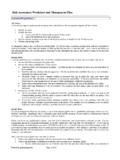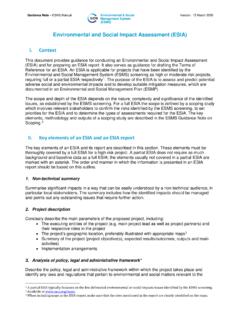Transcription of Drilling hazard management: The value of risk assessment
1 World Oil OCTOBER 2010 43 ADVANCES IN DRILLINGSpECIAL FoCuS: Drilling hazard management : the value of risk assessmentPart 2 of 3: Correctly interpreting Drilling dynamics enables operators to make the right proactive decisions during Pritchard, Successful Energy Practices International; Patrick L. York, Scott Beattie and Don Hannegan, Weatherford success with Drilling hazard management (DHM) depends on recog-nition of the project s risks . If executed effectively, the process yields a compre-hensive awareness that provides a foun-dation not only to mitigate risk but also to optimize operations. Risk assessment can be conducted for any operation.
2 This article presents a flexible, iterative process that allows evaluation of planned mitigations that may create further risks . The implementation of this process can be used to critically challenge each facet of the well assessment should be applied at the following stages of the well planning process: Analysis: Evaluating design alter-natives for potential risks , hazards and benefits facilitates selection of the best approach. Design: The basis of design doc-ument provides specifics of the selected alternative and requires more focused evaluation. Execution: Risk assessments of all procedures, logistics, communica-tions, etc.
3 , should be conducted to en-sure that all risks are managed, to help minimize non-productive time and to sustain performance. For any change in the scope of the operation, the management of change document should be accompanied by a risk assessment of any new procedures, practices or technologies. (Within this article, we will deal only with risk of me-chanical success and efficiency risk, not risks associated with health, safety and the environment.)Three alternative responses succinctly sum up how risk can be managed: accept, mitigate or avoid. Accepting a risk means that the likelihood and consequence of the risk event actually happening ranks so low that it is an acceptable risk to un-dertake.
4 This likelihood is commonly referred to as as low as reasonably prac-tical (ALARP). Mitigating means that the risk, as currently understood, is not acceptable and requires new or addition-al intervention. These new mitigations can come in the form of best practices, policies, procedures, techniques and technologies that better manage the risk. Avoiding usually requires revising the well design or mitigant in place or elimi-nating a step or a risk matrix as a guidance tool enables the team to select any action that it determines to be reasonable and appropriate for the operation. A matrix provides a vehicle for documenting and organizing what is important to better understand the risk profiles of the opera-tions and manage accordingly.
5 Decisions are guided by company policies, rules or regulations, as well as those of the rel-evant regulatory information, a clear scope and well-defined objectives are needed to con-duct a focused risk assessment . The first step of the process is to perform due dili-gence and collect all pertinent data avail-able. Adequate data collection should in-clude the most current information from all sources and stakeholders. Data can come from multiple sources including, but not limited to, local, regional and global well histories, reports, studies and personal assessment success depends on the quality and range of the participants knowledge and experience.
6 A broad knowledge base and a wide range of ex-pertise produce better results. Drilling engineering peers and personnel of other disciplines, such as geoscientists and reser-voir and production engineers, should be integral sources of input during discussion and planning. Providers of critical services should also be included in the degree of rigor applied to the risk assessment process should be commensu-rate with the complexity of the well. Al-though the process can be tedious, it be-gins by defining the scope of each separate risk assessment session, the sum of which make up the process. All stakeholders in-volved need to provide their expertise; it is important for the stakeholders of various disciplines to fully understand the impact of their own objectives, procedures and requirements and to be prepared to brain-storm on any given operational the scope of each ses-sion allows the stakeholders to use their own experiences and knowledge to dis-cern possible and probable risks and haz-ards.
7 Asking what if opens the session to speculative scenarios. If, for example, the session scope is risk assessment of tripping the drillstring, the what ifs would include such risks as stuck pipe, loss of circulation and swabbing. Partici-pants prepared to bring their experiences and knowledge to identify risks and haz-ards help the team use time efficiently, stay within the scope, and compile a comprehensive RISK assessment SESSIONSThe initial risk assessment session should be conducted in a multidisci-plinary environment to collect risks and associated consequences from the stake-holders.
8 All participants should be given an opportunity to identify their risks and consequences, which can be accomplished through simple brainstorming. Once the what ifs are identified, consequences can be determined by asking so what. 44 OCTOBER 2010 World OilSpECIAL FoCuS ADVANCES IN DRILLINGI dentification of potential risks and their consequences constitutes the risk regis-ter , the full list of what ifs and so whats associated with all to a few basic rules can help ensure an effective session. They include appointing an unbiased facilita-tor and an excellent scribe; reviewing the risk assessment tool and its capabilities; and defining and communicating the session s scope before beginning.
9 In addi-tion, it is important to maintain reason-able time limits for sessions; experience suggests that anything over two hours can be counterproductive. The risk reg-ister should be completed offline by the engineer or another person responsible for the project or well. Do not debate or wordsmith the brainstorming session; simply allow each person to offer his or her ideas and record them in the register. Work out granularity and details offline. The idea of a brainstorming session is to record, simply and concisely, the risks and associated consequences that collec-tively constitute the risk assessment PROCESSThe risk assessment process is dynamic and should be continually reviewed and updated with the most current informa-tion.
10 Because a consequence can also be-come a new risk, the assessment process can be somewhat circular in nature. For example, if the risk is fluid loss and the consequence is stuck pipe, this conse-quence becomes a new risk that generates a new consequence, such as that the pipe becoming irretrievably stuck. The key to addressing circular issues is managing the worst-case risk event first. This approach usually resolves circular issues and the original risk itself. The risk then eventual-ly becomes mitigated and thus risk can be superfluous, or deemed so by some of the stake-holders. For example, a driller might be concerned about the risk of sticking a wireline tool given hole conditions, while a geologist might not think it is a problem.






